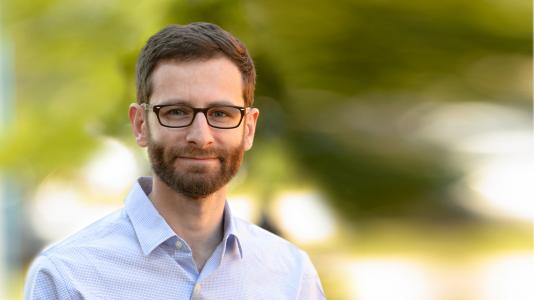
Computational Materials Scientist, AMD
Education: PhD in Mechanical Engineering (Georgia University of Technology), BS in Mechanical Engineering (Tufts University)
Hobbies: Cooking (and eating) international cuisines, playing tabletop roleplaying games, listening to music/podcasts
Noah Paulson enjoys being a Computational Materials Scientist in Argonne National Laboratory’s Applied Materials Division (AMD), where he uses machine learning and a variety of other skills to solve important problems affecting the world. His studies into how different materials are created help him and fellow scientists improve the production of key items such as batteries, preparing us for new scientific breakthroughs and tools that will change our everyday lives.
Curious about the world – “Not much has changed for me!” he noted – Noah was interested in both art and technology since he was little. He maintained both interests over the years, so when he started applying for universities, he decided to focus on mechanical engineering. “I chose it because it seemed to be a good mix of science and creativity,” he explained. When he studied to earn his Ph.D. so he could qualify for technical work, he did a dissertation on materials, which in turn led him to pursuing materials science.
Noah’s current work as a Computational Materials Scientist at Argonne requires him to use statistics and machine learning to analyze the development of materials along with their key properties and internal structure. These materials are created through a wide variety of tools, ranging from 3D printing to flame spray pyrolysis. In his work, Noah collaborates with experts in numerous areas such as mathematics, electrochemistry, and artificial intelligence. “It’s exciting to work every day with teams dedicated to solving important problems the world faces,” he said.
Machine learning in particular has become important for materials science, as it can enable scientists to perform critical simulations and calculations for materials that they could not do otherwise. For instance, Noah’s team combines machine learning tools with physics simulations for hundreds of atoms, with the result allowing them in turn to simulate the processes for thousands to millions of atoms. “We can’t do that with the original physics simulations because they require far too much computational power,” Noah noted.
Machine learning and AI tools help researchers understand battery composition, how long batteries last, and how to improve them. Currently, materials scientists are developing batteries that use solid electrolytes rather than liquid, which will make them safer and able to store more energy. With such a battery, an electric car could drive 600 miles on just one charge. “Before we get there though, we need to identify the best solid electrolyte material and figure out how to make it at a low enough cost to put it in even the cheapest vehicles,” Noah said.
Noah recognizes that many students find basic STEM classes to be dull, just like they were for him as a kid. However, he encourages youth to push through with the classes regardless, because knowing the fundamentals for science is crucial. “Not only will it help you with the courses but the fundamental concepts are what you’ll end up using when you have to solve a real problem,” he emphasized. “Luckily, applying the things you learn in class is the fun part.” He also advises students to take internships, or even volunteer at a professor’s lab.
In addition, Noah urges students to take the time to find and make friends while they’re young, even as they move forward on STEM pathways. “Middle and high school are not the easiest time for most people, so having friends that genuinely care about you can make a big difference,” he said. Furthermore, he says not to give up, even when things seem challenging. “When it comes to school, you are capable of a lot more than you might think. Believe in your abilities and work hard to back it up.”